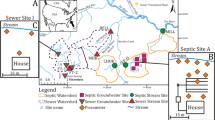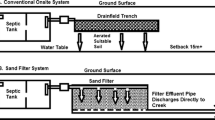Abstract
Eutrophication related to excess phosphorus (P) loadings continues to be an important issue for watersheds in North Carolina and other regions. Identifying the contributing sources of P in nutrient-sensitive waters is important for improving water quality. Prior studies have indicated that onsite wastewater treatment systems (OWS) can be a contributing source of P to surface waters, but more information is needed regarding their contribution relative to other wastewater treatment technologies. The goal of this study was to determine if P concentrations in groundwater and surface water were significantly different in a coastal plain watershed served by OWS in comparison to a watershed served by a municipal sewer system (MWS). Groundwater P concentrations were monitored at ten residential sites (five5 OWS and five MWS) once during each season (four times), and stream P concentrations and watershed exports were monitored monthly for 1 year (August 2011–August 2012). Groundwater in the OWS watershed had higher P concentrations than the MWS watershed. Stream P concentrations and P exports were also elevated in the OWS watersheds. However, the OWS were more efficient at reducing P prior to surface water discharge than the wastewater treatment plant that served the MWS watershed. The site-scale and watershed-scale P treatment efficiencies of OWS were between 73 and 99 %, whereas P treatment efficiency for the wastewater treatment plant was 54 %. While the OWS were efficient at reducing P concentrations and loads, OWS were still significant sources of P exports from the studied watershed. Potential contributions of P from OWS should be included in watershed nutrient management strategies along with other known sources such as agriculture and urban runoff if the strategies are to be considered comprehensive.









Similar content being viewed by others
References
Arnscheidt, J., Jordan, P., Li, S., McCormick, S., McFaul, R., McGrogan, H. J., Neal, M., & Sims, J. T. (2007). Defining the sources of low-flow phosphorus transfers in complex catchments. Science of the Total Environment, 382, 1–13.
Brady, N. C., & Weil, R. R. (2004). Elements of the nature and property of soils (2nd ed., p. 101). New Jersey: Prentice-Hall.
Burkholder, J. M., Dickey, D. A., Kinder, C. A., Reed, R. E., Mallin, M. A., McIver, M. R., Cahoon, L. B., Melia, G., Brownie, C., Smith, J., Deamer, N., Springer, J., Glasgow, H. B., & Toms, D. (2006). Comprehensive trend analysis of nutrients and related variables in a large eutrophic estuary: a decadal study of anthropogenic and climatic influences. Limnology and Oceanograrphy, 51, 463–487.
Conley, D. J., Paerl, H. W., Howarth, R. W., Boesch, D. F., Seitzinger, S. P., Havens, K. E., Lancelot, C., & Likens, G. E. (2009). Controlling eutrophication: nitrogen and phosphorus. Science, 323, 1014–1015.
Corbett, D. R., Dillon, K., Burnett, W., & Schaefer, G. (2002). The spatial variability of nitrogen and phosphorus concentration in a sand aquifer influenced by onsite sewage treatment and disposal systems: a case study on St. George Island, Florida. Environmental Pollution, 117(2), 337–345.
Day, P. R. (1979) Particle size fractionation and particle size analysis in methods of soil analysis part 1. 1st edition, (pp. 545–567). Black, C. A., Evans, D., White, J. L., Ensminger, L. E., & Clark, F. E. (Eds.), AmericanSociety of Agronomy, Madison, WI.
Del Rosario, K. L., Humphrey, C. P., Mitra, S., & O’Driscoll, M. (2014a). Nitrogen and carbon dynamics beneath on-site wastewater treatment systems in Pitt County, North Carolina. Journal of Water Science and Technology, 69(3), 663–671.
Del Rosario, K., Mitra, S., Humphrey, C., & O’Driscoll, M. (2014b). Detection of pharmaceuticals and other personal care products in groundwater beneath and adjacent to onsite wastewater treatment systems in a coastal plain shallow aquifer. Science of the Total Environment, 487, 216–223.
Domenico, P. A., & Schwartz, W. (1998). Physical and chemical hydrogeology (2nd ed., p. 115). New York: Wiley.
Ferrell, G. M., & Grimes, B. H. (2014). Effects of centralized and onsite wastewater treatment on the occurrence of traditional and emerging contaminants in streams. Journal of Environmental Health, 76(6), 18–27.
Gill, L. W., O’Luanaigh, N., Johnston, P. M., Misstear, B. D. R., & O’Suilleabhain, C. (2009). Nutrient loading on subsoils from on-site wastewater effluent, comparing septic tank and secondary treatment systems. Water Research, 43, 2739–2749.
Gold, A. J., & Sims, J. T. (2000). Risk-based decision making for onsite wastewater treatment, National Research Needs Conference Proceedings: EPRI, Palo Alto, CA, U.S. Environmental Protection Agency, and National Decentralized Water Resources Capacity Development Project: 2001. 1001446.
Greenville Utilities Commission (2012). Wastewater annual report. http://www.guc.com/client_resources/wwar2012.pdf. Accessed 5 November 2013.
Hardy, D.H., Tucker, M.R., & Stokes, C. (2013). Understanding the soil test report. North Carolina Department of Agriculture & Consumer Services Agronomic Division Publication. http://www.ncagr.gov/agronomi/pubs.htm. Accessed 1 Aug 2014.
Harris, J., Humphrey, C. P., & O’Driscoll, M. A. (2013). Transport of indicator microorganisms from an onsite wastewater system to adjacent stream. Universal Journal of Environmental Research and Technology, 3(3), 423–426.
Humphrey, C. P., & O’Driscoll, M. A. (2011). Biogeochemistry of groundwater beneath on-site wastewater systems in a coastal watershed. Universal Journal of Environmental Research and Technology, 1(3), 320–328.
Humphrey, C. P., O’Driscoll, M. A., Deal, N., & Lindbo, D. (2014a). Fate and transport of phosphate from an on-site wastewater system in Beaufort County, North Carolina. Journal of Environmental Health, 76(6), 28–34.
Humphrey, C., O’Driscoll, M., & Harris, J. (2014b). Spatial distribution of fecal indicator bacteria in groundwater beneath two large on-site wastewater treatment systems. Water, 6(3), 602–619.
Karathanasis, A. D., Mueller, T. G., Boone, B., & Thompson, Y. L. (2006). Nutrient removal from septic effluents as affected by soil thickness and texture. Journal of Water and Health, 4(2), 177–195.
Lautier, J.C. (2001). Hydrogeologic framework and ground-water conditions in the North Carolina central coastal plain (p. 4). North Carolina Department of Environment and Natural Resources, Division of Water Resources.
Line, D. (2013). Effect of development of water quality for seven streams in North Carolina. Environmental Monitoring and Assessment, 185, 6277–6289.
Lowe, K. S., Rothe, N. K., Tomaras, J. M. B., DeJong, K., Tucholke, M. B., Drewes, J., McCray, J. E., & Munakata-Marr, J. (2007). Influent constituent characteristics of the modern waste stream from single sources: literature review. Alexandria: Water Environment Research Foundation.
Macintosh, K. A., Jordan, P., Cassidy, R., Arnscheidt, J., & Ward, C. (2011). Low flow water quality in rivers: septic tank systems and high-resolution phosphorus signals. Science of the Total Environment, 412–413, 58–65.
Mehlich, A. (1984). Mehlich-3 soil test extractant: a modification of Mehlich-2 extractant. Communications in Soil Science and Plant Analysis, 15(12), 1409–1416.
National Oceanic and Atmospheric Administration (1996). NOAA’s estuarine eutrophication survey. Volume 1: South Atlantic Region (pp. 3.). Silver Spring, MD: Office of Ocean Resources Conservation Assessment.
North Carolina Division of Water Resources (2014a). Nutrient strategies. http://portal.ncdenr.org/web/wq/ns. Accessed 11 Aug 2014.
North Carolina Division of Water Resources (2014b). Point source agreements. http://portal.ncdenr.org/web/wq/ps/nps/tarpampointsource. Accessed 4 Nov 2014.
O’Driscoll, M. A., Humphrey, C. P., Jr., Deal, N. E., Lindbo, D. L., & Zarate-Bermudez, M. A. (2014). Meteorological influences on nitrogen dynamics of a coastal onsite wastewater treatment system. Journal of Environmental Quality. doi:10.2134/jeq2014.05.0227.
Omoike, A. I., & Vanloon, G. W. (1999). Removal of phosphorus and organic matter removal by alum during wastewater treatment. Water Research, 33(17), 3617–3627.
Osmond, D. L., Neas, K., Johnson, A. M., & Cahill, S. L. (2013). Fertilizer use in regulated river basins: is it what we think? Journal of Contemporary Water Research & Education, 151, 20–26.
Paerl, H. W. (2009). Controlling eutrophication along the freshwater-maries continuum: dual nutrient (N and P) reductions are essential. Estuaries and Coasts, 32, 593–601.
Postma, F. B., Gold, A. J., & Loomis, G. W. (1992). Nutrient and microbial movement from seasonally-used septic systems. Journal of Environmental Health, 55(2), 5–10.
Pradhan, S., Hoover, M.T., Austin, R.E., Devine, H.A. (2007). Potential nitrogen contributions from on-site wastewater treatment systems to North Carolina’s river basins and sub-basins. North Carolina Agricultural Research Service Technical Bulletin 324, Raleigh, North Carolina.
Ptacek, C. J. (1998). Geochemistry of a septic system plume in a coastal barrier bar, Point Pelee, Ontario Canada. Journal of Contaminant Hydrology, 33, 293–312.
Reay, W. G. (2004). Septic tank impacts on groundwater quality and nearshore sediment nutrient flux. Groundwater, 42(7), 1079–1089.
Robertson, W. D., Schiff, S. L., & Ptacek, C. J. (1998). Review of phosphate mobility and persistence in ten septic system plumes. Ground Water, 36, 1000–1010.
Standard Methods for the Examination of Water and Wastewater (1998). 20th edn, American Public health Association/American Water Works Association/Water Environment Federation, Washington DC.
State Climate Office of North Carolina (2014). Climate normals for Greenville, NC. http://www.nc-climate.ncsu.edu/cronos/normals.php. Accessed 10 Nov 2013.
U. S. Census (2013). State & County QuickFacts. Greenville (city), North Carolina. United States Census Bureau. http://quickfacts.census.gov/qfd/states/37/3728080.html. Accessed 7 May 2013.
U. S. Department of Agriculture, Natural Resources Conservation Service Web Soil Survey (2012). Soil survey of Pitt County, North Carolina. http://websoilsurvey.sc.egov.usda.gov/App/HomePage.htm. Accessed 14 Feb 2012.
U. S. Environmental Protection Agency (1998). Environmental monitoring and assessment program-surface waters: field operations and methods for measuring the ecological condition of wadeable streams. EPA/620/R-94/004F.
U. S. Environmental Protection Agency (2002). Onsite wastewater treatment systems manual. EPA/625/R-00/008.
Valiela, I., & Costa, J. E. (1988). Eutrophication of buttermilk bay, a Cape Cod coastal embayment: concentrations of nutrients and watershed nutrient budgets. Environmental Management, 12(4), 539–553.
Withers, P. J. A., Jarvie, H. P., & Stoate, C. (2011). Quantifying the impact of septic tank systems on eutrophication risk in rural headwaters. Environment International, 37, 644–653.
Zanini, L., Robertson, W. D., Ptacek, C. J., & Schiff, S. L. (1998). Phosphorus characterization in sediments impacted by septic effluent at four sites in central Canada. Journal of Contaminant Hydrology, 33, 405–429.
Acknowledgments
We would like to thank the North Carolina Department of Environment and Natural Resources 319 Non-point Source Program for providing funding for this project. We would also like to thank Hannah Postma, AJ Finley, Matt Smith, John Woods, Jim Watson, Colleen Rochelle, Katie Del Rosario, and Johnathan Harris for assistance with field and/or lab work.
Author information
Authors and Affiliations
Corresponding author
Rights and permissions
About this article
Cite this article
Humphrey, C.P., Anderson-Evans, E., O’Driscoll, M. et al. Comparison of Phosphorus Concentrations in Coastal Plain Watersheds Served by Onsite Wastewater Treatment Systems and a Municipal Sewer Treatment System. Water Air Soil Pollut 226, 2259 (2015). https://doi.org/10.1007/s11270-014-2259-4
Received:
Accepted:
Published:
DOI: https://doi.org/10.1007/s11270-014-2259-4




